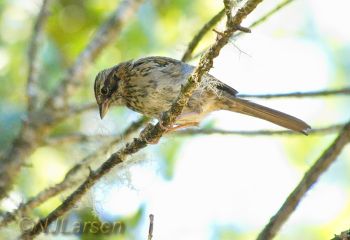- Zonotrichia capensis
Identification

Notice the breast streaking on this bird which therefore presumably is a younger bird
Photo © by njlarsen
Valle Nuevo (Cordillera Central), Dominican Republic, September 2013
11·8–13·4 cm (4¾-5¼)
- Conical grey bill
- Grey head
- Broad black stripes on the crown sides
- Thin stripes through the eye and below the cheeks
- White throat
- Rufous nape and breast sides
- Buffish-brown upperparts with black streakss
- Two white wing bars
- Whitish underparts
- Brown flanks
- Black breast patch
Young birds have a duller, less distinct head pattern, with brown stripes and a buff ground colour. They lack the rufous collar, and have streaked underparts.
Variation
This is a very variable species[2]. Most subspecies with a strong crest, and with variation on how strongly patterned and dark the face is. Another heavily variable trait is extent of streaking, and to some extent color of neck band and breast band.
Subspecies australis: is larger than other races, lacks crown stripes, and has longer wings. It is one of the few subspecies that is migratory, moving north as far as Bolivia after nesting.
Distribution
All of South America except for the Amazon and Orinoco basins, Central America, southern Mexico, and Hispaniola.
Taxonomy
Subspecies
This is a polytypic species consisting of twenty-seven subspecies are currently recognized[1] (but revision has been called for[2]):
- Z. c. septentrionalis: Highlands of southern Mexico (Chiapas) to Guatemala and Honduras
- Z. c. antillarum: Cordillera Central of Dominican Republic
- Z. c. costaricensis: Mountains of Costa Rica to western Panama; Andes of Colombia, western Venezuela
- Z. c. insularis: Aruba and Curaçao
- Z. c. venezuelae: Coastal cordillera of northern Venezuela
- Z. c. roraimae: Southern Colombia (Meta) to eastern Venezuela, western Guyana and adjacent northern Brazil
- Z. c. inaccessibilis: Tepuis of southern Venezuela (Cerro de la Neblina)
- Z. c. perezchinchillorum: Tepuis of southern Venezuela (Amazonas)
- Z. c. macconelli: Tepuis of southern Venezuela (Mount Roraima)
- Z. c. capensis: French Guiana (lower Oyapock River) and adjaent Brazil (Amapá)
- Z. c. tocantinsi: Eastern Brazil (lower Amazonia along Rio Tocantins)
- Z. c. novaesi: Easst Brazil (Pará)
- Z. c. matutina: North-East Brazil (Maranhão to Bahia and Mato Grosso) and adjacent eastern Bolivia
- Z. c. huancabambae: Arid northern Peru (Piura, Cajamarca, Amazonas, San Martín and Junín)
- Z. c. illescasensis: North Peru (Cerro Illescas in Piura)
- Z. c. peruviensis: Arid coastal Peru and western slope of Andes (La Libertad to Tacna)
- Z. c. carabayae: Eastern slope of Eastern Andes of Peru (Junín) to western Bolivia
- Z. c. pulacayensis: Andes of Peru (Junín) to western Bolivia and northern Argentina
- Z. c. subtorquata: East Brazil (Espírito Santo) to Paraguay, Uruguay and north-eastern Argentina
- Z. c. mellea: Central Paraguay and adjacent north-central Argentina (Formosa)
- Z. c. hypoleuca: East and southern Bolivia to north-eastern Argentina
- Z. c. antofagastae: North Chile (Tarapacá and Antofagasta)
- Z. c. chilensis: Chile (Atacama to Islas Guaitecas) and Andes of southern Argentina
- Z. c. sanborni: Andes of Chile (Coquimbo, Aconcagua) and Argentina (San Juan)
- Z. c. arenalensis: Andes of northern Argentina
- Z. c. choraules: West Argentina (Mendoza, e Neuquén and Río Negro)
- Z. c. australis: South Chile and southern Argentina to Cape Horn; winters north to Bolivia
Habitat
Cultivated open areas, gardens, parks and scrubland to alpine meadows. Mostly above 600 meters above sea level, though it can occur even in coastal areas (e.g. Lima and most of Chile, where it is one of the commonest birds).
Behaviour
Breeding
The cup-shaped nest is built by the female. It iss constructed from plant material and lined with fine grass. It is placed in dense vegetation on the ground, low in a tree or bush, or maybe a wall crevice. The clutch consists of 2-3 greenish-blue eggs with brown blotches. Incubation lastss about 12-14 days. The male helps to feed the chicks.
In Brazil these sparrows are parasitized by Shiny Cowbirds, which show a marked preference for their nests.
Diet
There is little firm information but their diet is likely to consist of seeds, fruit and arthropods, foraged on or near the ground.
Vocalisation
Song: a series of whistles ending with a trill. The song varies quite a lot geographically
References
- Clements, J. F., T. S. Schulenberg, M. J. Iliff, S. M. Billerman, T. A. Fredericks, B. L. Sullivan, and C. L. Wood. 2019. The eBird/Clements Checklist of Birds of the World: v2019. Downloaded from http://www.birds.cornell.edu/clementschecklist/download/
- Birdforum thread discussing subspecies of Rufous-collared Sparrow
- Handbook of the Birds of the World Alive (retrieved July 2016)
- BF Member observations
Recommended Citation
- BirdForum Opus contributors. (2024) Rufous-collared Sparrow. In: BirdForum, the forum for wild birds and birding. Retrieved 16 June 2024 from https://www.birdforum.net/opus/Rufous-collared_Sparrow
External Links
GSearch checked for 2020 platform.1








